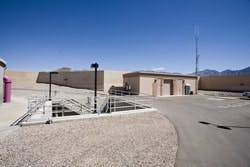| Related Searches from WaterInfoLink.com Water Reuse | Southern Arizona | Sodium Hypochlorite Generation System | Severn Trent Services | Town of Oro Valley Water Utility |
Southern Arizona’s population growth in the last 20 years has created severe challenges for the region’s water resources. For the fastest growing municipality in that part of the state, those challenges created the opportunity to develop an innovative use of reclaimed water.
Oro Valley provides nearly three billion gallons of potable water to its customers every year. Currently, the city is overdrafting the groundwater supply in its aquifer because the demand on its wells significantly exceeds the aquifer’s natural recharge.
Groundwater levels have declined more than 4 to 5 ft per year in the last several years due primarily to a years-long drought and increased demand on the aquifer from the rapidly growing population. The development of renewable water resources has been a necessity to help reduce the city’s reliance on groundwater and preserve its groundwater resources, so non-potable water reclamation strategies have become a primary focus in recent years.
In October 2005, the Town of Oro Valley Water Utility unveiled a new reclaimed water storage and booster facility. The utility’s Rancho Vistoso Pump Station, which receives reclaimed water from nearby Tucson Water, was outfitted with a ClorTec CT-75 onsite sodium hypochlorite generation system from Severn Trent Services .
The system produces 75 lb per day of sodium hypochlorite at a 0.8% solution and has a total storage capacity of 2,500 gal. Tucson Water’s Thornydale Pump Station pumps the chlorinated reclaimed water through approximately 29,300 linear ft of 24-in. cast iron (CI) pipe to the Rancho Vistoso Reservoir, which has a capacity of 1.3 million gal. Reclaimed water is then pumped from the reservoir and delivered to three local golf courses that are from ? of a mile to 2 miles from the pump station through 12- and 16-in. CI pipeline.
The town’s objective is to provide enough chlorine residual in the reclaimed water to prevent algae growth—a problem in Arizona’s hot summer months—in the Rancho Vistoso Reservoir and in the pipeline that leaves the reservoir.
The three golf courses call in their orders for their daily water needs by 9 a.m. each day. A telemetry unit calculates the water amounts—in manageable increments—to be delivered to each of the courses. In a typical summer day, the Rancho Vistoso station will pump 3.75 million gal of reclaimed water treated by the onsite sodium hypochlorite generation process to the courses.
In investigating different disinfection options required for the reclaimed water, the town established a baseline need to increase the chlorine residual to 2.4 parts per million (ppm) from 1.5 ppm total chlorine equivalent. As with many utilities, employee and community safety are important considerations for the Town of Oro Valley Water Utility, and safety and cost reasons were key to selecting onsite generation of 0.8% sodium hypochlorite rather than the use and bulk storage of 12% liquid chlorine. The intense Arizona sun makes bulk sodium hypochlorite a less-than-desirable alternative, too, because it degrades quickly in hot temperatures.
Sending reclaimed water instead of groundwater to the golf courses is saving 3.75 million gal of drinkable water each day, reducing demand on the aquifer by 15% annually. Where the water utility’s wells were working at about 90% capacity, well water utilization has now dropped to around 50%.
In addition to the sodium hypochlorite generation system, the utility uses a RMS Water Storage Management System from Severn Trent Services at the Rancho Vistoso Reservoir to solve the problem of maintaining uniform levels of chlorine throughout water storage reservoirs and ground storage tanks, significantly reducing thermal stratification, stagnation and blending of different water qualities.
The RMS system uses real-time water quality samples from inside the water storage tank to automatically detect and feed the level of total chlorine required to maintain a consistent predetermined residual.
According to Jeff Kane, lead operator/production facilities for the Town of Oro Valley Water Utility, the system has operated well, helping the town to more carefully manage its precious water supply with an innovative reuse strategy that has been predicted by some water experts to be the “way of the future” in the Western U.S.
